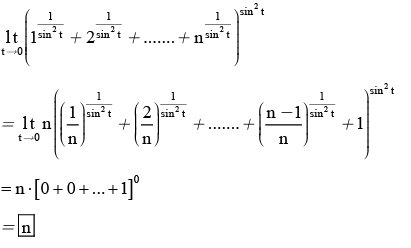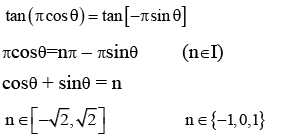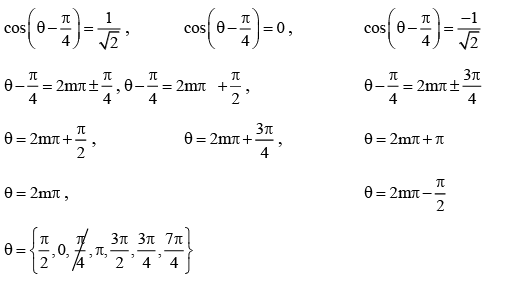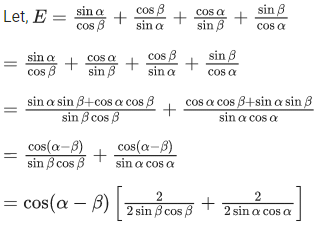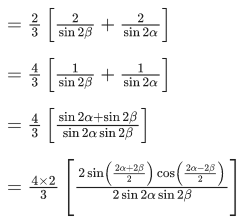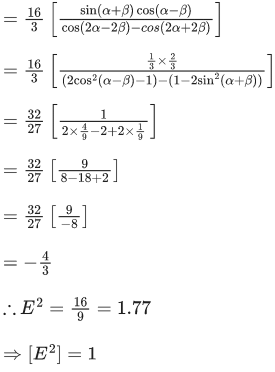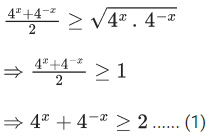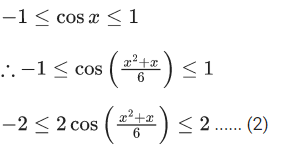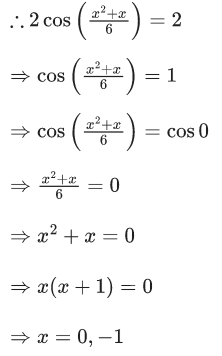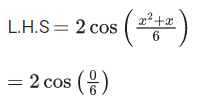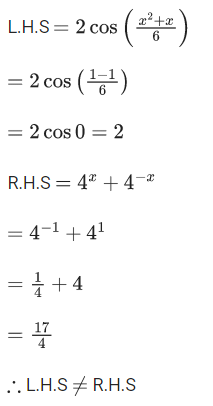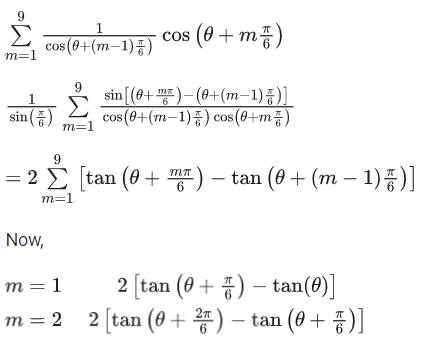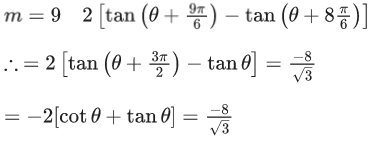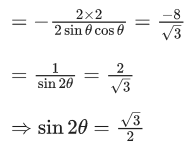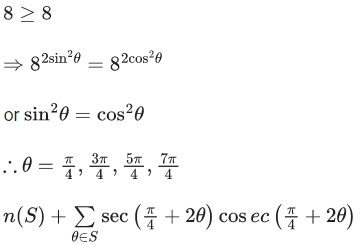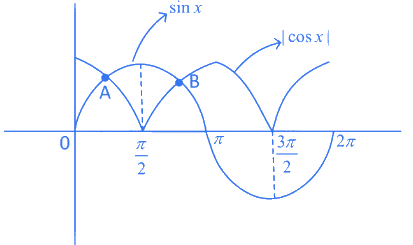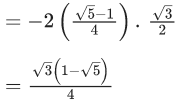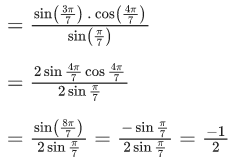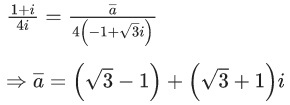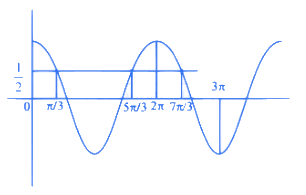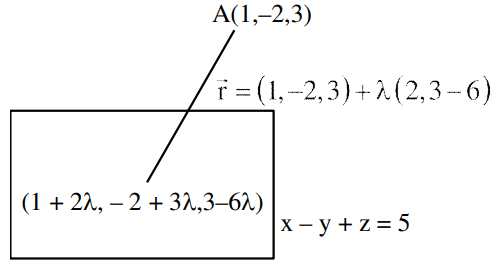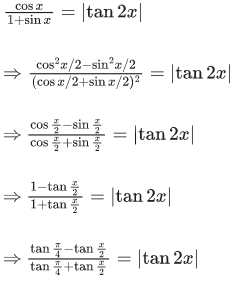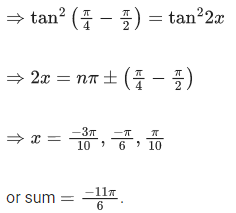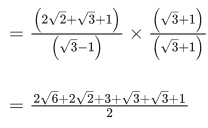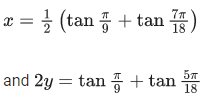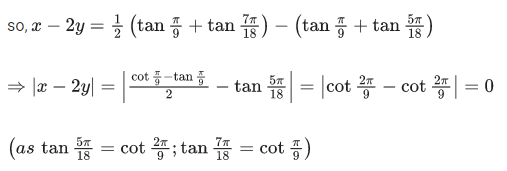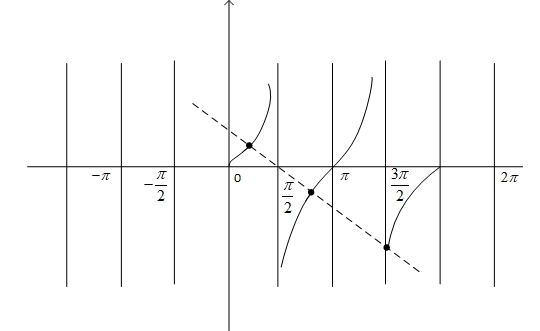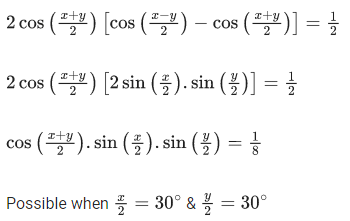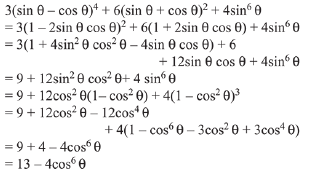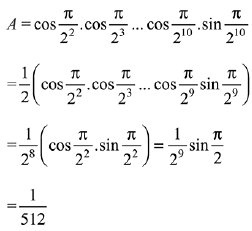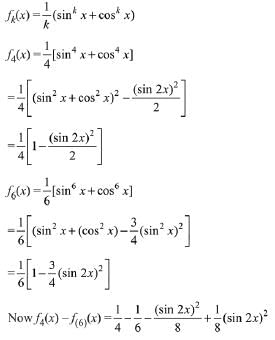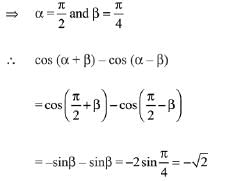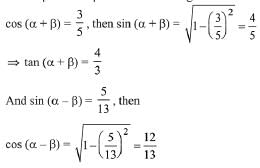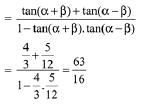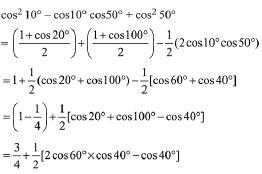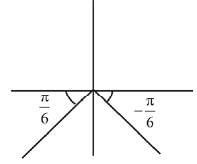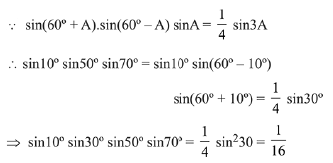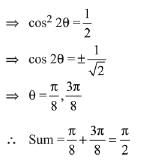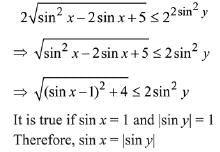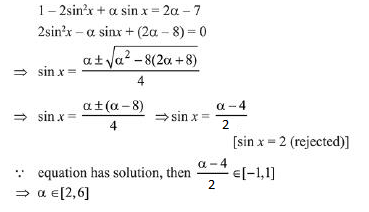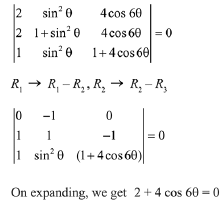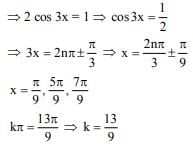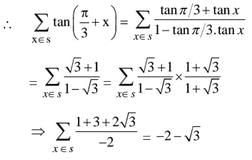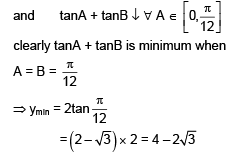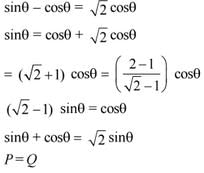JEE Main Previous Year Questions (2016-2025): Trigonometric Functions & Equations | 35 Years Chapter wise Previous Year Solved Papers for JEE PDF Download
Q.1.  (JEE Main 2023)
(JEE Main 2023)
(a) n2
(b) 
(c) n
(d) n2 + n
Ans. c
Q.2. Let S = {θ ∈ [0,2π): tan(πcosθ) + tan( πsinθ) = 0}. (JEE Main 2023)
Ans. 2
Q.3. Let α and β be real numbers such that 
If sin(α + β) = 13 and cos(α − β) = 2/3, then the greatest integer less than or equal to is (JEE Advanced 2022)
is (JEE Advanced 2022)
Ans. 1
Given, sin(α + β) = 1/3
and cos(α − β) = 2/3
Q.4. The number of elements in the set (JEE Main 2022)
(JEE Main 2022)
(a) 1
(b) 3
(c) 0
(d) infinite
Ans. a
Given,
We know,
A.M ≥ G.M
∴ for 4x and 4−x
And we know,
(1) and (2) both satisfies only when both equal to 2.
When x = 0,
= 2 cos 0
= 2.1
= 2
R.H.S = 4x + 4−x
= 40 + 40
= 2
∴ x = 0 is accepted.
Now, when x = −1,
∴ x = −1 is not a solution.
∴ Only one solution possible which is x = 0.
Q.5.
Then (JEE Main 2022)
(a) 
(b) 
(c) 
(d) 
Ans. c
2θ = π/3
2θ = 2π/3
θ = π/6
θ = π/3
Q.6. (JEE Main 2022)
(JEE Main 2022)
(a) 0
(b) -2
(c) -4
(d) 12
Ans. c
Now apply AM ≥ GM for
= 4 - 2(4)
= 4 - 8
= -4
Q.7. 2 sin (π/22) sin (3π/22) sin (5π/22) sin (7π/22) sin (9π/22) is equal to : (JEE Main 2022)
(a) 3/16
(b) 1/16
(c) 1/32
(d) 9/32
Ans. b
= 1/16
Q.8. The number of solutions of |cos x|= sin x, such that − 4π ≤ x ≤ 4π is : (JEE Main 2022)
(a) 4
(b) 6
(c) 8
(d) 12
Ans. c
Period of |cosx| = π
And period of sinx = 2π
Graph of sin x and |cos x| cuts each other at two points A and B in [0, 2π]
So, in [−4π, 4π], total 4 similar graph will be present and graph of sin x and |cos x| will cut 4 × 2 = 8 times.
∴ Total possible solutions = 8.
Q.9. Let S = {θ ∈ [-π, π] - {± π/2} : sinθ tanθ + tanθ = sin 2θ}
If  then T + n(S) is equal to: (JEE Main 2022)
then T + n(S) is equal to: (JEE Main 2022)
(a) 7 + √3
(b) 9
(c) 8 +√3
(d) 10
Ans. b
Q.10. The number of solutions of the equation (JEE Main 2022)
(JEE Main 2022)
(a) 8
(b) 5
(c) 6
(d) 7
Ans. d
⇒ cos22x − 2cos2x − 1 = 0
⇒ cos 2x = 1
∴ x = −3π, −2π, −π, 0, π, 2π, 3π
∴ Number of solutions = 7
Q.11. The value of 2sin (12∘) − sin (72∘) is : (JEE Main 2022)
(a) 
(b) 
(c) 
(d) 
Ans. d
2 sin 12∘ − sin 72∘
= sin 12∘ + (−2cos 42∘. sin 30∘)
= sin 12∘ − cos 42∘
= sin 12∘ − sin 48∘
= sin 18∘ . cos 30∘
Q.12. 16 sin(20∘)sin(40∘)sin(80∘) is equal to: (JEE Main 2022)
(a) √3
(b) 2√3
(c) 3
(d) 4√3
Ans. b
16 sin 20∘ . sin 40∘ . sin 80∘
= 4 sin 60∘ {∵ 4 sinθ . sin(60∘ − θ) . sin(60∘ + θ) = sin 3θ}
= 2√3
Q.13. The value of cos(2π/7) + cos(4π/7) + cos(6π/7) is equal to : (JEE Main 2022)
(a) -1
(b) 
(c) 
(d) 
Ans. b
Q.14. α = sin36∘ is a root of which of the following equation? (JEE Main 2022)
(a) 16x4 − 10x2 − 5 = 0
(b) 16x4 + 20x2 − 5 = 0
(c) 16x4 − 20x2 + 5 = 0
(d) 16x4 − 10x2 + 5 = 0
Ans. c
α = sin36∘ = x (say)
⇒16x2 = 10 − 2√5
⇒ (8x2 − 5)2 = 5
⇒ 16x4 − 80x2 + 20 = 0
∴ 4x4 - 20x2 + 5 = 0
Q.15. Let for some real numbers α and β, a = α − iβ. If the system of equations 4i x + (1 + i)y = 0 and  has more than one solution, then α/β is equal to (JEE Main 2022)
has more than one solution, then α/β is equal to (JEE Main 2022)
(a) -2√3
(b) 2 - √3
(c) 2 + √3
(d) - 2 - √3
Ans. b
Given a = α − iβ and
4i x + (1 + i)y = 0 ...... (i)
By
By (ii)
Now by (iii) and (iv)
Q.16. If cot α = 1 and sec β =  where π < α < 3π/2 and π/2 < β < π, then the value of tan(α + β) and the quadrant in which α + β lies, respectively are : (JEE Main 2022)
where π < α < 3π/2 and π/2 < β < π, then the value of tan(α + β) and the quadrant in which α + β lies, respectively are : (JEE Main 2022)
(a)  and IVth quadrant
and IVth quadrant
(b) 7 and Ist quadrant
(c) −7 and IVth quadrant
(d) 1/7 and Ist quadrant
Ans. a
Q.17. If n is the number of solutions of the equation and S is the sum of all these solutions, then the ordered pair (n, S) is: (JEE Main 2021)
and S is the sum of all these solutions, then the ordered pair (n, S) is: (JEE Main 2021)
(a) (3, 13π / 9)
(b) (2, 2π / 3)
(c) (2, 8π / 9)
(d) (3, 5π / 3)
Ans. a
2 cos x(2 − 4sin2x − 1) = 1
2cosx(1 − 4sin2x) = 1
2cos x(4cos2x − 3) = 1
4 cos3x − 3cos x = 1/2
cos 3x = 1/2
x∈[0, π] ∴ 3x ∈[0, 3π]
Q.18. The number of solutions of the equation (JEE Main 2021)
(JEE Main 2021)
(a) 3
(b) 1
(c) 0
(d) 2
Ans. b
taking log of base 32 both side,
As value ofbelongs to (0, 1).
In interval 0 ≤ x ≤ π/4 only one solution.
Q.19. The distance of the point (1, −2, 3) from the plane x − y + z = 5 measured parallel to a line, whose direction ratios are 2, 3, −6 is : (JEE Main 2021)
(a) 3
(b) 5
(c) 2
(d) 1
Ans. d
(1 + 2λ) + 2 − 3λ + 3 − 6λ = 5
⇒ 6 − 7λ = 5 ⇒ λ = 17
Q.20. 2 sin(π/8) sin(2π/8) sin(3π/8) sin(5π/8) sin(6π/8) sin(7π/8) is : (JEE Main 2021)
(a) 1/4√2
(b) 1/4
(c) 1/8
(d) 1/8√2
Ans. c
Q.21. The sum of solutions of the equation  (JEE Main 2021)
(JEE Main 2021)
(a) 
(b) π/10
(c) 
(d) 
Ans. a
Q.22. If sin θ + cosθ = 1/2, then 16(sin(2θ) + cos(4θ) + sin(6θ)) is equal to: (JEE Main 2021)
(a) 23
(b) -27
(c) -23
(d) 27
Ans. c
sin θ + cos θ = 1/2
sin2θ + cos2θ + 2sinθ cosθ = 14
Now :
cos4θ = 1 − 2sin22θ
sin6θ = 3sin 2θ − 4sin32θ
= (3 − 4sin22θ).sin2θ
16[sin 2θ + cos 4θ + sin 6θ]
Q.23. The value of cot π/24 is : (JEE Main 2021)
(a) √2 + √3 + √2 − √6
(b) √2 + √3 + 2 + √6
(c) √2 − √3 − 2 + √6
(d) 3√2 − √3 − √6
Ans. b
θ = π/24
Q.24. If tan(π/9), x , tan(7π/18) are in arithmetic progression and tan(π/9), y, tan(5π/18) are also in arithmetic progression, then |x − 2y| is equal to: (JEE Main 2021)
(a) 4
(b) 3
(c) 0
(d) 1
Ans. c
Q.25. The sum of all values of x in [0, 2π], for which sin x + sin 2x + sin 3x + sin 4x = 0, is equal to : (JEE Main 2021)
(a) 8π
(b) 11π
(c) 12π
(d) 9π
Ans. d
(sin x + sin 4x) + (sin 2x + sin 3x) = 0
So, sum = 6π + π +2π = 9π
Q.26. If 15 sin4α + 10 cos4α = 6, for some α ∈ R, then the value of 27 sec6α + 8 cosec6α is equal to : (JEE Main 2021)
(a) 500
(b) 400
(c) 250
(d) 350
Ans. c
15 sin2α + 10(1 − sin2α)2 = 6
⇒ 25sin2α − 20sin2α + 4 = 0
⇒ 25sin2α − 10 sin2α − 10 sin2α + 4 = 0
⇒ (5 sin2α − 2)2 = 0 ⇒ sin2α = 2/5
∴ cos2α = 3/5
= 125 + 125 = 250
Q.27. The number of solutions of the equation x + 2 tan x = π/2 in the interval [0, 2π] is : (JEE Main 2021)
(a) 4
(b) 3
(c) 2
(d) 5
Ans. b
x + 2 tan x = π/2 in [0, 2π]
y = tan x and y
3 intersection points on the graph.
∴ 3 solutions.
Q.28. If for x ∈ (0, π/2), log10 sin x + log10 cos x = −1 and log10(sin x + cos x) = 1/2(log10 n − 1), n > 0, then the value of n is equal to : (JEE Main 2021)
(a) 16
(b) 9
(c) 12
(d) 20
Ans. c
log10(sin x) + log10(cos x) = −1
sin x cos x = 1/10 .... (1)
and log10(sin x + cos x) = 1/2(log10n − 1)
⇒ sinx + cosx = (n/10)1/2
⇒ sin2x + cos2x + 2 sin x cos x = n/10 (squaring)
⇒ n/10 = 12/10
⇒ n = 12
Q.29. The number of roots of the equation,  in the interval [0, π] is equal to : (JEE Main 2021)
in the interval [0, π] is equal to : (JEE Main 2021)
(a) 2
(b) 3
(c) 4
(d) 8
Ans. c
t2 − 30t + 81 = 0
t2 − 27t − 3t + 81 = 0
(t − 3)(t − 27) = 0
t = 3, 27
in [0, π ] sin x > 0
Number of solution = 4
Q.30. If 0 < x, y < π and cosx + cosy − cos(x + y) = 3/2, then sinx + cosy is equal to : (JEE Main 2021)
(a) 
(b) 1/2
(c) 
(d) 
Ans. a
x = y = 60∘
Q.31. All possible values of θ ∈ [0, 2π] for which sin 2θ + tan 2θ > 0 lie in : (JEE Main 2021)
(a) 
(b) 
(c) 
(d) 
Ans. d
Q.32. If  satisfies the equation t2 - 9t + 8 = 0, then the value of
satisfies the equation t2 - 9t + 8 = 0, then the value of  (JEE Main 2021)
(JEE Main 2021)
(a) √3
(b) 3/2
(c) 2√3
(d) 1/2
Ans. d
Given, t2 − 9t + 8 = 0 ⇒ t = 1, 8
Q.33. If y(α) = 
 then dy/dα at
then dy/dα at is: (2020)
is: (2020)
(a) 4
(b) 4/3
(c) -4
(d) -1/4
Ans. a
We have
(since 1 + tan2α = sec2α)
y(α) = -1 - cotα
Now,
Q.34. If  = 1/7 and
= 1/7 and  , α, β ∈
, α, β ∈ , then tan (α + 2β) is equal to ___________. (2020)
, then tan (α + 2β) is equal to ___________. (2020)
Ans. 1.00
We have
and
Q.35. The value of  is: (2020)
is: (2020)
(a) 1/(√2)
(b) 1/(2√2)
(c) 1/2
(d) 1/4
Ans. b
Given
Q.36. The number of distinct solutions of the equation, in the interval [0, 2π] is_________. (2020)
in the interval [0, 2π] is_________. (2020)
Ans. 8.00
Given,
Now,Hence, there are 8 solutions of the given equation in the interval (0, 2π).
Q.37. If and
and  then: (2020)
then: (2020)
(a) x(1+y) = 1
(b) y(1-x) = 1
(c) y(1+x) = 1
(d) x(1-y) = 1
Ans. b
We have................. (1)
Similarly,
x = cos2θ ..............(2)
From Eqs. (1) and (2), we get
Q.38. For any  the expression
the expression
3(sinθ - cosθ)4 + 6(sinθ + cosθ)2 + 4sin6θ equals: (2019)
(a) 13 - 4cos2θ + 6sin2θcos2θ
(b) 13 - 4cos6θ
(c) 13 - 4cos2θ + 6cos4θ
(d) 13 - 4cos4θ + 2sin2θcos2θ
Ans. b
Q.39. The value of  is: (2019)
is: (2019)
(a) 1/512
(b) 1/1024
(c) 1/256
(d) 1/2
Ans. a
Q.40. Let  for k = 1, 2, 3,... Then for all x ∈ R, the value of f4(x)-f6(x) is equal to: (2019)
for k = 1, 2, 3,... Then for all x ∈ R, the value of f4(x)-f6(x) is equal to: (2019)
(a) 1/12
(b) 1/4
(c) -1/12
(d) 5/12
Ans. a
= 1/12
Q.41. If sin4α + 4 cos4β + 2 =  sin α cos β; α, β ∈ [0,π], then cos(α + β) - cos(α - β) is equal to: (2019)
sin α cos β; α, β ∈ [0,π], then cos(α + β) - cos(α - β) is equal to: (2019)
(a) 0
(b) -1
(c) √2
(d) -√2
Ans. d
∵ The given equation is
Then, by A.M., G.M. inequality;
A.M. ≥ G.M.
Inequality still holds when cosβ < 0 but L.H.S. is positive as cosβ > 0, then
L.H.S. = R.H.S
Q.42.  then tan(2α) is equal to: (2019)
then tan(2α) is equal to: (2019)
(a) 63/52
(b) 63/16
(c) 21/16
(d) 33/52
Ans. b
∵ α + β and α - β both are acute angles.
⇒ tan (α - β) = 5/12
Now, tan 2α = tan ((α + β) + (α - β))
Q.43. The value of cos210° - cos10° cos50° + cos250° is: (2019)
(a) 3/4 + cos20°
(b) 3/4
(c) 3/2 (1 + cos20°)
(d) 3/2
Ans. b
=3/4
Q.44. Let S = {θ∈[-2 π, 2π] : 2 cos2θ + 3 sinθ = 0}. Then the sum of the elements of S is: (2019)
(a) 13π/6
(b) 5π/3
(c) 2π
(d) π
Ans. c
The required sum of all solutions in [-2π, 2π] is
Q.45. The value of sin 10° sin 30° sin 50° sin 70° is: (2019)
(a) 1/16
(b) 1/32
(c) 1/18
(d) 1/36
Ans. a
Q.46.  then the number of values of x for which sin x - sin 2x + sin 3x = 0, is: (2019)
then the number of values of x for which sin x - sin 2x + sin 3x = 0, is: (2019)
(a) 3
(b) 1
(c) 4
(d) 2
Ans. d
sinx - sin2x + sin3x = 0
⇒ sinx - 2 sinx.cosx + 3 sinx - 4 sin3x = 0
⇒ 4 sinx - 4 sin3x - 2 sinx.cosx = 0
⇒ 2 sinx(1-sin2x) - sinx.cosx = 0
⇒ 2 sinx.cos2x - sinx.cosx = 0
⇒ sinx.cosx(2 cosx - 1) = 0
Q.47. The sum of all values of  satisfying sin2 2θ + cos4 2θ = 3/4 is: (2019)
satisfying sin2 2θ + cos4 2θ = 3/4 is: (2019)
(a) π
(b) 5π/4
(c) π/2
(d) 3π/8
Ans. c
...(1)
∵ G.M. ≤ A.M.
= 1/4 ...(2)
So, from eq. (1) & (2), we get
G.M. = A.M.
It is possible only if,
Q.48. All the pairs (x,y) that satisfy the inequality  also satisfy the equation: (2019)
also satisfy the equation: (2019)
(a) 2|sinx| = 3 sin y
(b) 2 sin x = sin y
(c) sin x = 2 sin y
(d) sin x = |sin y|
Ans. d
Given inequality is,
Q.49. The number of solutions of the equation  is: (2019)
is: (2019)
(a) 3
(b) 5
(c) 7
(d) 4
Ans. b
Consider equation, 1 + sin4x = cos23x
L.H.S. = 1 + sin4x and R.H.S. = cos23x
∵ L.H.S. ≥ 1 and R.H.S. ≤ 1 ⇒ L.H.S. = R.H.S. = 1
sin4x = 0, and cos23x = 1
⇒ sin x = 0 and (4cos2x - 3)2 cos2x = 1
⇒ sin x = 0 and cos2x = 1 ⇒ x = 0, ±π, ±2π
Hence, total number of solutions is 5.
Q.50. Let S be the set of all α ∈ R such that the equation, cos 2x + α sin x = 2α -7 has a solution. Then S is equal to: (2019)
(a) R
(b) [1,4]
(c) [3,7]
(d) [2,6]
Ans. d
Given equation is, cos 2x + α sin x = 2α - 7
Q.51. A value of θ ∈ (0, π/3), for which  (2019)
(2019)
(a) π/9
(b) π/18
(c) 7π/24
(d) 7π/36
Ans. a
c1→ c1 + c2
Q.52. If [x] denotes the greatest integer ≤ x, then the system of linear equations
[sin θ] x + [-cos θ] y = 0
[cot θ] x + y = 0 (2019)
(a) Have infinitely many solutions if  and has a unique solution if
and has a unique solution if 
(b) Has a unique solution if 
(c) Has a unique solution if  and have infinitely many solutions if
and have infinitely many solutions if 
(d) Have infinitely many solutions if 
Ans. a
According to the question, there are two cases.
In this interval, [sin θ] = 0, [-cos θ] = 0 and [cot θ] = -1
Then the system of equations will be;
0 · x + 0 · y = 0 and -x + y = 0
Which have infinitely many solutions.
In this interval, [sin θ] = -1 and [-cos θ] = 0,
Then the system of equations will be;
-x + 0 · y = 0 and [cot θ] x + y = 0
Clearly, x = 0 and y = 0 which has unique solution.
Q.53. If sum of all the solution of equation  in [0,π ] is kπ,then k is equal to: (2018)
in [0,π ] is kπ,then k is equal to: (2018)
(a) 2/3
(b) 13/9
(c) 8/9
(d) 20/9
Ans. b
⇒ 6 cos x - 8 cos x sin2 x - 4 cos x = 1
⇒ 2 cos x - 8 cos x (1 - cos2 x) = 1
Q.54. If tanA and tanB are the roots of the quadratic equation, 3x2 - 10x - 25 = 0, then the value of 3 sin2(A +B) - 10 sin(A +B).cos(A+B) - 25 cos2(A + B) (2018)
(a) -25
(b) 10
(c) -10
(d) 25
Ans. a
Since tanA and tanB are roots of the equation 3x2 - 10x - 25 = 0
Q.55. If an angle A of a ΔABC satisfies 5 cosA + 3 = 0, then the roots of the quadratic equaiton, 9x2 + 27x + 20 = 0 are: (2018)
(a) secA, cotA
(b) secA, tanA
(c) tanA, cosA
(d) sinA, secA
Ans. b
5cosA + 3 = 0 ⇒ cosA = -3/5 clearly A ∈ (90º, 180º)
Now roots of equation 9x2 + 27x + 20 = 0 are -5/3 and -4/3
⇒ Roots secA and tanA
Q.56. If 5 (tan2x – cos2x) = 2cos 2x + 9, then the value of cos 4x is: (2017)
(a) -7/9
(b) -3/5
(c) 1/3
(d) 2/9
Ans. a
5 tan2x = 9 cos2x + 7
5 sec2x – 5 = 9 cos2x + 7
Let cos2x = t
cos4x = 2 cos2 2x – 1
Q.57. If  Then
Then  (2017)
(2017)
(a) 
(b) 
(c) 
(d) 
Ans. b
Q.58. If 0 ≤ x < 2π, then the number of real values of x, which satisfy the equation cos x + cos 2x = cos 3x + cos 4x = 0, is (2016)
(a) 3
(b) 5
(c) 7
(d) 9
Ans. c
We have, cosx + cos2x + cos 3x + cos 4x = 0
(cos x + cos 4x)+ (cos 2x+ cos 3x)= 0
Or
Solutions are
… (0 ≤ x < 2π)
Q.59. The number of x ∈ [0, 2π] for which is: (2016)
is: (2016)
(a) 6
(b) 4
(c) 8
(d) 2
Ans. c
Clearly 8 solutions.
Q.60. If A > 0, B > 0 and A + B = π/2 then the minimum value of tanA + tanB is: (2016)
(a) 2 - √3
(b) 2/√3
(c) √3 - √2
(d) 4 - 2 √3
Ans. d
A, B > 0 and A + B = π/2
Let y = tanA + tanB
Q.61. Let P = {θ : sinθ - cosθ = √2 cos θ} and Q = {θ : sinθ + cos θ = √2 sinθ} be two sets. Then: (2016)
(a) Q ⊄ P
(b) P ⊄ Q
(c) P ⊂ Q and Q - P ≠ ϕ
(d) P = Q
Ans. d
|
347 docs|185 tests
|

